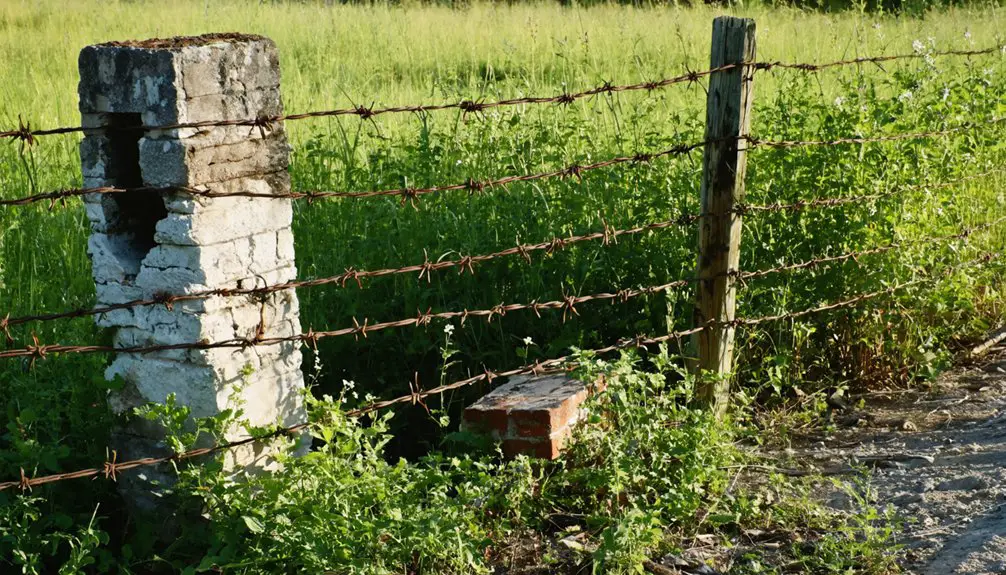You’ll find Hamburg’s ghost town remains within today’s Weldon Spring Conservation Area in Missouri. Founded by German immigrants in 1840 along the Missouri River, this once-bustling river port thrived on steamboat trade and rail commerce until 1941. That’s when the U.S. Army acquired 17,232 acres for wartime explosives production, forcing residents to abandon their homes. Archaeological traces, including building foundations and lost cemeteries, still hold untold stories of this displaced community.
Key Takeaways
- Hamburg, Missouri became a ghost town in 1941 when the U.S. Army acquired 17,232 acres for wartime explosives production.
- The entire population of 576 citizens was forced to relocate, abandoning their homes and businesses for the Weldon Spring Project.
- Archaeological remains include visible building foundations, intact fireplaces, and evidence of historic road cuts and ferry landings.
- Multiple historic cemeteries, including Friedens German-English Evangelical Cemetery, were abandoned during the 1941 military acquisition.
- Environmental contamination from TNT production led to restricted access and required a billion-dollar cleanup effort completed in 2002.
The Birth of a River Town (1840-1844)
While German immigrants were establishing new settlements along the Missouri River, Hamburg emerged in 1840 as a strategically positioned river town amid existing Anglo-American communities.
You’ll find that Bavarian settlers chose this location for its prime position along the Missouri River bluffs, where they could tap into essential river commerce and the newly established Missouri-Kansas-Texas Railroad line. Gottfried Duden’s promotion of Missouri’s Rhine-like qualities attracted many German settlers to the region.
Similar to how the original Hamburg gained status as a free imperial city in 1189, this new Hamburg aimed to establish itself as an independent trading center along the Missouri River.
The town’s early prosperity hinged on its dual transportation advantages, with a bustling train depot serving as a hub for local farmers and traders.
However, flood challenges quickly shaped Hamburg’s destiny. The Great Flood of 1844 forced residents to adapt, splitting the settlement between Upper and Lower Hamburg.
The devastating 1844 flood reshaped Hamburg’s landscape, dividing the resilient community into two distinct settlements along the bluffs.
While some stayed near the river and rail facilities below, others relocated their homes and businesses to the safety of the bluffs above.
Life Along the Missouri River
Because the Missouri River served as an essential transportation artery, life in Hamburg revolved around the bustling river trade of the 1840s.
You’d have seen steamboats and flatboats constantly moving agricultural goods downstream while bringing manufactured items upriver. The town’s river commerce connected local farmers to lucrative markets in Natchez and Louisiana, where they’d sell their surplus crops.
Life wasn’t just about agricultural practices – you’d have encountered fur traders stopping at Hamburg while traversing between trading posts, and lead miners transporting their ore to market. Many merchants used large bateaux for cargo transport along the waterways. Native American tribes like the Otoe and Missouria maintained trading relationships with the settlers.
The town’s mixed population included French-speaking settlers working alongside enslaved African Americans, who made up about 20% of the regional population.
Religious life centered around occasional visits from Catholic priests and Protestant preachers, who’d minister to the townspeople.
Cultural Heritage and Notable Residents
Hamburg’s cultural heritage shines through the talents of acclaimed jazz pianist Ralph Sutton, who got his start performing at the Riverview Park dance hall built by his father Earl Sutton and Theodore Mades.
You’ll find evidence of skilled craftsmanship in the work of John E. Schneider, whose distinctive coverlets are now preserved in prestigious museums like the Saint Louis Art Museum and Art Institute of Chicago.
The town’s artistic legacy emerges through these notable residents and the physical remnants of German immigrant culture, from preserved stonework to architectural features that still dot the former townsite. The Heck-Roth Cemetery remains a testament to the town’s history, including the grave of Philip Heck, a Civil War musician who contributed to the area’s rich musical tradition. Like its namesake city in Germany, the town served as a crucial departure point for many Eastern European emigrants seeking new opportunities across America.
Musical Legacy Lives On
Despite its transformation into a ghost town, the musical legacy of Hamburg, Missouri endures through the influential career of jazz pianist Ralph Sutton, who was born there in 1922.
His musical influences took root at the Riverview Park dance hall, built by his father Earl and Theodore Mades specifically to showcase local talent.
The town’s proximity to St. Louis shaped its jazz history, connecting Hamburg to the wider Missouri music scene.
You’ll find Sutton’s early performances from the 1930s at Riverview Park marked the beginning of his journey as a celebrated stride pianist.
Today, his recordings preserve Hamburg’s cultural impact, while historical markers and documentaries continue to tell the story of this once-vibrant musical community, ensuring its artistic contributions won’t be forgotten. The World War II displacement of residents ended the town’s musical gatherings, but not before leaving an indelible mark on jazz history.
Artisans Shape Local History
Skilled artisans carved out Hamburg’s cultural identity during its heyday, with John E. Schneider leading the way as one of the first coverlet weavers west of the Mississippi. You’ll find his masterful textiles preserved in prestigious institutions like the Saint Louis Art Museum and Art Institute of Chicago.
Hamburg’s artisan techniques reflected its German immigrant roots, with craftsmen preserving traditional methods in textiles, woodworking, and building construction. Local artisans contributed their cultural craftsmanship to the town’s architectural elements, including the Riverview Park dance hall built by Earl Sutton and Theodore Mades. The nearby KATY Trail State Park now attracts thousands of cyclists past the area’s historic sites. The deteriorating remains of a boy scout camp still stand as evidence of the area’s continued use through the decades.
These skilled workers served the agricultural community while maintaining their heritage through specialized trades. Today, while the town no longer stands, artifacts like Schneider’s coverlets provide tangible links to Hamburg’s rich artisan legacy.
The Weldon Spring Project’s Impact
Your quiet hometown of Hamburg would be forever altered when the U.S. Army acquired 17,232 acres in 1941 for wartime explosives production at Weldon Spring.
The military’s transformation of the area into a TNT manufacturing site forced local families to abandon their homes, farms, and the once-thriving limestone quarry business.
The sacrifice of Hamburg’s entire community marked the beginning of a 70-year legacy of restricted access and environmental contamination that would permanently prevent residents from returning to their ancestral lands. The Department of Energy later spent 1 billion dollars cleaning up the contaminated Weldon Spring Quarry in 2002.
Military Transformation Begins
When World War II demanded rapid military expansion in 1941, the U.S. Army executed a massive military acquisition near Weldon Spring, Missouri, claiming 17,232 acres for the war effort.
This strategic move forever changed the landscape and lives of local residents, including the complete dissolution of the town of Hamburg.
The transformation brought four significant changes to the area:
- Construction of four TNT production lines within the Chemical Plant area
- Displacement of 576 citizens from their ancestral homes
- Conversion of farmland into a massive ordnance works facility
- Introduction of nitroaromatic contamination that would later require extensive environmental remediation
This dramatic shift marked the beginning of Weldon Spring’s five-decade journey through military, nuclear, and chemical operations, permanently altering the region’s character and environmental status.
Community Sacrifices Everything
The Weldon Spring Project‘s acquisition of 17,232 acres in Saint Charles County delivered a devastating blow to local communities in 1940-41, forcing the evacuation of Hamburg, Howell, and Toonerville.
You’ll find no trace of these once-thriving towns today – they were systematically demolished or burned to make way for the massive ordnance works.
Despite their strong community resilience, residents watched helplessly as their homes, businesses, churches, and schools vanished overnight.
This historical erasure transformed the social fabric of Saint Charles County forever.
The U.S. Army’s urgent need for TNT production during WWII trumped all local interests, and families had no choice but to relocate.
Their sacrificed communities would soon be replaced by a sprawling industrial complex employing over 5,000 workers for the war effort.
Wartime Transformation

During World War II, Hamburg’s transformation from a thriving riverside community to a military-industrial complex began with the federal government’s forcible evacuation of residents in 1940-1941.
Despite strong community resilience, wartime policies dramatically altered this once-vibrant town, converting farmland and homes into the Weldon Spring Ordnance Works.
The transformation included:
- Demolition of existing buildings, leaving only foundations and chimneys
- Construction of munitions production facilities for the war effort
- Severing of essential transportation links, including railroad connections
- Conversion of civilian infrastructure for restricted military use
You’ll find that Hamburg’s strategic location along the Missouri River, which once made it a prosperous trading hub, ultimately sealed its fate as the perfect site for wartime industrial development.
Physical Remnants and Archaeological Findings
Despite extensive demolition efforts in 1940, Hamburg’s physical remnants offer compelling archaeological evidence of its once-thriving riverside community.
You’ll find visible foundations of residential homes and commercial buildings scattered throughout the area, along with intact fireplaces and chimneys that have withstood time. Archaeological discoveries reveal historic road cuts on Hamburg Hill and ferry landings that once served as critical transportation links.
The Hamburg Quarry’s limestone walls stand as a reflection of the town’s industrial past, though it later became a controversial storage site.
Beneath the Missouri River’s floodplain sediments, submerged archaeological features preserve evidence of early settlement patterns, ferry operations, and trading activities.
While many structural remains await proper documentation, these physical traces continue to tell Hamburg’s story through careful archaeological investigation.
The Lost Cemeteries of Hamburg
Beyond Hamburg’s visible foundations and quarry walls lie sacred grounds that tell an even deeper story of the vanished community.
Throughout the former town site, you’ll find several lost cemeteries that reflect Hamburg’s diverse heritage, including German-English and African-American residents.
Key cemetery sites include:
- Friedens German-English Evangelical Cemetery, showcasing the town’s European roots
- McRoberts Cemetery, a small African-American family burial ground with unmarked graves
- Roth-Heck Cemetery, representing early settler families
- Iman, Mades, Richard Pitman, and Scott Cemeteries, scattered across the landscape
Cemetery preservation efforts face significant challenges since the 1941 creation of Weldon Spring Ordnance Works.
While most town structures vanished, these burial grounds remain as vital historical landmarks, though many are now overgrown and difficult to access.
Legacy in Transportation History
When Hamburg first emerged as a transportation hub in 1840, its strategic location between the Missouri River and the newly established Missouri-Kansas-Texas Railroad line made it an ideal nexus for trade and commerce.
You can trace Hamburg’s transportation evolution through its response to the Great Flood of 1844, which forced residents to split the town between Upper and Lower Hamburg. The MKT railroad depot became essential for shipping agricultural goods, while the river trade gradually diminished.
Economic shifts in the mid-20th century spelled the end for Hamburg as major transportation routes bypassed the town.
Today, you’ll find remnants of this rich transport heritage along the Katy Trail, where the old quarry and depot site stand as silent witnesses to Hamburg’s former glory as a significant transit point.
Frequently Asked Questions
Are There Any Known Photographs of Hamburg Before Its Demolition?
You won’t find confirmed photographs of this historically significant site before its 1940 demolition. The lost architecture and local heritage remain undocumented visually, though physical ruins still tell their story.
What Happened to the Displaced Residents After Leaving Hamburg?
Most residents joined the 4,000+ population of North Augusta by 1923. You’ll find their displacement impact echoed through generations as families shifted from river trade to agricultural work and wage labor.
Were Any Valuable Artifacts Recovered During the Town’s Demolition?
You won’t find documented artifact recoveries of significance during the demolition. Military priorities and rapid clearance in 1940 meant cultural preservation wasn’t a focus, leaving minimal evidence of preserved historical items.
Is It Legal to Visit the Hamburg Ghost Town Site Today?
You’ll need explicit permission since ghost town laws require landowner consent. Check visiting guidelines with Barry County officials first, as unauthorized access could result in trespassing charges under Missouri statutes.
Did Any Businesses From Hamburg Relocate and Survive Elsewhere?
You won’t find any documented business legacy or relocation history of surviving Hamburg enterprises elsewhere – government mandates for the ordnance works forced complete closure rather than allowing planned business transfers.
References
- https://www.youtube.com/watch?v=6q0rXcrvBKE
- http://thetntstory.blogspot.com/2010/11/normal-0-microsoftinternetexplorer4_21.html
- https://en.wikipedia.org/wiki/Hamburg
- https://en.wikipedia.org/wiki/List_of_ghost_towns_in_Missouri
- https://www.youtube.com/watch?v=a-AygB2G7kc
- https://en.wikipedia.org/wiki/History_of_Hamburg
- https://mostateparks.com/sites/mostateparks/files/Wolf-Ruebeling House.pdf
- https://www.gasconadecountyhistoricalsociety.com/hermann-missouri
- https://collections.shsmo.org/manuscripts/columbia/C2366/st-charles-county
- https://www.nps.gov/parkhistory/online_books/ozar/hrs3.htm



